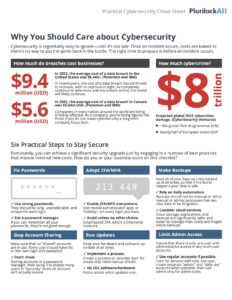Deep Dive into Extended Detection and Response (XDR) in Cybersecurity
In the ever-evolving landscape of cybersecurity threats, organizations are constantly seeking innovative solutions to protect their digital assets and sensitive information. One such solution that has gained significant attention and adoption in recent years is Extended Detection and Response (XDR). XDR represents a paradigm shift in cybersecurity, offering a holistic approach to threat detection, investigation, and response. In this deep dive, we will explore what XDR is, why it matters, and provide an in-depth analysis of its importance in today’s complex threat landscape.
Understanding Extended Detection and Response (XDR)
Defining XDR
Extended Detection and Response, commonly referred to as XDR, is a comprehensive cybersecurity framework designed to provide organizations with enhanced threat detection and response capabilities. At its core, XDR integrates multiple security products and data sources, including endpoints, networks, cloud environments, and applications, to provide a unified view of an organization’s security posture.
XDR goes beyond traditional endpoint detection and response (EDR) solutions, which focus primarily on identifying threats on individual devices. Instead, it encompasses a broader set of security data sources and leverages advanced analytics, artificial intelligence (AI), and machine learning (ML) to correlate and analyze data from across the entire IT environment. This holistic approach enables security teams to detect and respond to threats more effectively, reducing the risk of breaches and minimizing the potential impact of security incidents.
Key Components of XDR
XDR typically includes the following key components:
- Endpoint Security: Endpoint detection and response (EDR) capabilities are a fundamental part of XDR. EDR tools monitor and analyze activities on individual devices, looking for signs of malicious behavior or unauthorized access.
- Network Security: XDR extends its reach to network security by integrating with network detection and response (NDR) tools. NDR solutions monitor network traffic to identify suspicious patterns and potential threats, helping to detect threats that may not manifest directly on endpoints.
- Cloud Security: With the increasing adoption of cloud services, XDR includes cloud security components to protect assets hosted in public, private, or hybrid cloud environments. This ensures that cloud-based threats are also taken into account.
- Identity and Access Management (IAM): XDR includes IAM data to track user and entity behaviors across the network and systems. This helps in identifying anomalies or unauthorized access attempts that might indicate a security breach.
- Threat Intelligence: Access to up-to-date threat intelligence feeds is crucial for XDR. Threat intelligence helps security teams stay informed about the latest threats and attack techniques, allowing them to proactively respond to emerging threats.
- Security Orchestration and Automation: XDR often includes automation and orchestration capabilities, enabling security teams to automate repetitive tasks and respond to threats more efficiently.
- Analytics and AI/ML: XDR leverages advanced analytics, AI, and ML to identify complex and evolving threats. These technologies enable XDR solutions to detect patterns and anomalies that might go unnoticed by traditional security tools.
- Incident Response: XDR facilitates incident response by providing a centralized console for security teams to investigate and remediate threats quickly.
The Evolution of XDR
XDR is a natural evolution of traditional cybersecurity approaches. It addresses the limitations of siloed security tools and the challenges of managing a complex, heterogeneous IT environment. The need for XDR has arisen due to several factors:
- Sophisticated Threats: Cyber threats have become increasingly sophisticated and capable of evading traditional security measures. Attackers often use multi-vector, multi-stage attacks that span across different parts of an organization’s infrastructure.
- Complex IT Environments: Organizations are embracing digital transformation and adopting cloud services, IoT devices, and remote work setups. This complexity makes it challenging to secure every endpoint effectively.
- Alert Fatigue: Traditional security solutions generate a multitude of alerts, many of which are false positives. Security teams can become overwhelmed by the sheer volume of alerts, leading to alert fatigue and missed real threats.
- Need for Automation: The shortage of skilled cybersecurity professionals has led to a growing reliance on automation and AI/ML to augment the capabilities of security teams. XDR integrates these technologies to improve threat detection and response.
Why XDR Matters
XDR is not just another cybersecurity buzzword; it represents a fundamental shift in how organizations approach cybersecurity. Its importance is evident in several key aspects:
1. Comprehensive Threat Detection
XDR’s ability to aggregate and correlate data from multiple sources provides organizations with a holistic view of their security posture. This comprehensive approach allows for the detection of complex, multi-stage attacks that might go unnoticed when relying solely on individual security tools. XDR identifies threats earlier in their lifecycle, reducing the dwell time of attackers within an organization’s network.
2. Reduced Alert Fatigue
One of the significant challenges in modern cybersecurity is the overwhelming number of alerts generated by various security tools. XDR helps alleviate this problem by consolidating alerts and using advanced analytics to prioritize them based on their severity and relevance. Security teams can focus their efforts on investigating and responding to genuine threats, rather than sifting through a sea of false positives.
3. Faster Incident Response
In the world of cybersecurity, speed is of the essence. XDR streamlines incident response by providing a centralized console that allows security teams to investigate and remediate threats more efficiently. Automation and orchestration capabilities can also play a vital role in accelerating response times, ensuring that threats are contained before they can cause significant damage.
4. Improved Visibility
XDR offers unparalleled visibility into an organization’s IT environment. This visibility extends to endpoints, networks, cloud services, and user activities. Having a clear understanding of the entire attack surface allows organizations to make informed decisions about their security posture and implement proactive measures to mitigate risks.
5. Adaptation to Modern IT Environments
As organizations embrace digital transformation and cloud computing, their security needs evolve. XDR is well-suited to address the security challenges posed by modern IT environments. It can seamlessly integrate with cloud services and provide protection for assets regardless of their location, whether on-premises or in the cloud.
6. Proactive Threat Hunting
XDR empowers security teams to engage in proactive threat hunting. Instead of waiting for alerts, security professionals can use XDR’s advanced analytics and threat intelligence to actively search for signs of compromise within their environment. This proactive approach helps organizations stay one step ahead of cyber adversaries.
7. Scalability
XDR solutions are designed to scale with an organization’s needs. Whether an organization is small or large, XDR can adapt to accommodate the volume of data and endpoints, ensuring that security remains effective as the organization grows.
8. Compliance and Reporting
Many industries have strict regulatory requirements concerning data security and privacy. XDR aids in compliance efforts by providing detailed logs, reports, and audit trails that demonstrate adherence to security standards and facilitate compliance audits.
9. Cost-Effective Security
While XDR solutions represent a significant investment, they often provide cost savings in the long run. By reducing the risk of security breaches and streamlining incident response, XDR can minimize the financial impact of cybersecurity incidents.
The Importance of XDR in Today’s Threat Landscape
XDR’s importance in today’s threat landscape cannot be overstated. Here are some key reasons why XDR is essential:
1. Advanced Persistent Threats (APTs)
Advanced persistent threats, often associated with nation-state actors and well-funded cybercriminal organizations, are a significant concern for organizations. These threats are characterized by their persistence and ability to evade traditional security measures. XDR’s holistic approach to threat detection and response is well-suited to detect and mitigate APTs, reducing the risk of long-term compromises.
2. Ransomware and Zero-Day Exploits
Ransomware attacks and zero-day exploits pose immediate and severe threats to organizations. XDR’s ability to identify unusual behavior and correlate data across different sources can help detect ransomware attacks in their early stages, preventing widespread encryption of critical data. Additionally, XDR can assist in identifying and mitigating zero-day exploits by detecting anomalous activity patterns.
3. Supply Chain Attacks
Supply chain attacks have become increasingly common, targeting organizations through their trusted vendors and suppliers. XDR’s extended reach into network and cloud security helps organizations monitor and secure their supply chain connections, reducing the risk of compromise through third-party vulnerabilities.
4. Insider Threats
Insider threats, whether malicious or unintentional, can have a significant impact on an organization’s security. XDR’s ability to monitor user and entity behavior helps in identifying suspicious activities that may indicate insider threats. It can also assist in distinguishing between normal and abnormal user behavior.
5. Rapidly Evolving Threat Landscape
The cyber threat landscape is in a constant state of flux, with new threats and attack techniques emerging regularly. XDR’s access to real-time threat intelligence and its ability to adapt to new threats make it an invaluable tool in staying ahead of cyber adversaries.
6. Remote Work Challenges
The shift to remote work brought about by the COVID-19 pandemic has introduced new security challenges. XDR can provide visibility into remote endpoints and cloud-based collaboration tools, ensuring that remote workers are adequately protected and that sensitive data remains secure.
7. Compliance Requirements
For organizations subject to regulatory compliance, XDR plays a critical role in meeting security and reporting requirements. XDR solutions can generate the necessary logs and reports to demonstrate compliance with data protection laws and industry-specific regulations.
8. Cybersecurity Skills Gap
The shortage of skilled cybersecurity professionals is a global concern. XDR’s automation and AI/ML capabilities help bridge the skills gap by automating routine tasks and enabling security teams to focus on more complex threat hunting and incident response activities.
Challenges and Considerations
While XDR offers significant advantages, its adoption is not without challenges and considerations:
1. Integration Complexity
Integrating various security tools and data sources into an XDR framework can be complex and time-consuming. Organizations need to carefully plan and execute the integration process to ensure that all components work seamlessly together.
2. Cost
XDR solutions can be expensive, especially for smaller organizations with limited budgets. However, the long-term cost savings in terms of reduced security incidents and faster incident response can outweigh the initial investment.
3. Skill Requirements
Effectively implementing and managing an XDR solution requires skilled cybersecurity professionals who understand the technology and can make the most of its capabilities. Organizations may need to invest in training or hire experienced personnel.
4. Privacy Concerns
Collecting and correlating data from various sources can raise privacy concerns. Organizations must carefully balance the need for security with the protection of user and customer privacy and ensure compliance with data protection regulations.
5. False Positives
While XDR aims to reduce alert fatigue, it is not immune to generating false positives. Organizations must fine-tune their XDR solutions to minimize false alerts and prevent unnecessary disruptions.
Conclusion
In an era of increasingly sophisticated cyber threats and complex IT environments, Extended Detection and Response (XDR) has emerged as a critical cybersecurity framework. XDR’s holistic approach to threat detection, investigation, and response provides organizations with the tools they need to stay ahead of cyber adversaries and protect their digital assets.
By integrating multiple security components, leveraging advanced analytics and AI/ML, and providing comprehensive visibility into an organization’s IT environment, XDR addresses the shortcomings of traditional cybersecurity approaches. It enables organizations to detect and respond to threats more effectively, reduce alert fatigue, and enhance their overall security posture.
In today’s ever-evolving threat landscape, XDR is not just a cybersecurity buzzword; it is a strategic imperative for organizations of all sizes and industries. As cyber threats continue to evolve, the importance of XDR in safeguarding critical data and systems will only grow, making it an essential tool in the cybersecurity arsenal of modern organizations.













